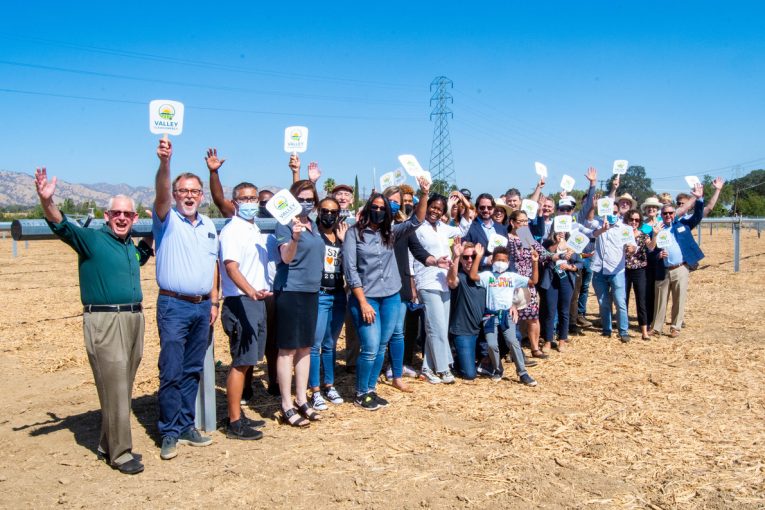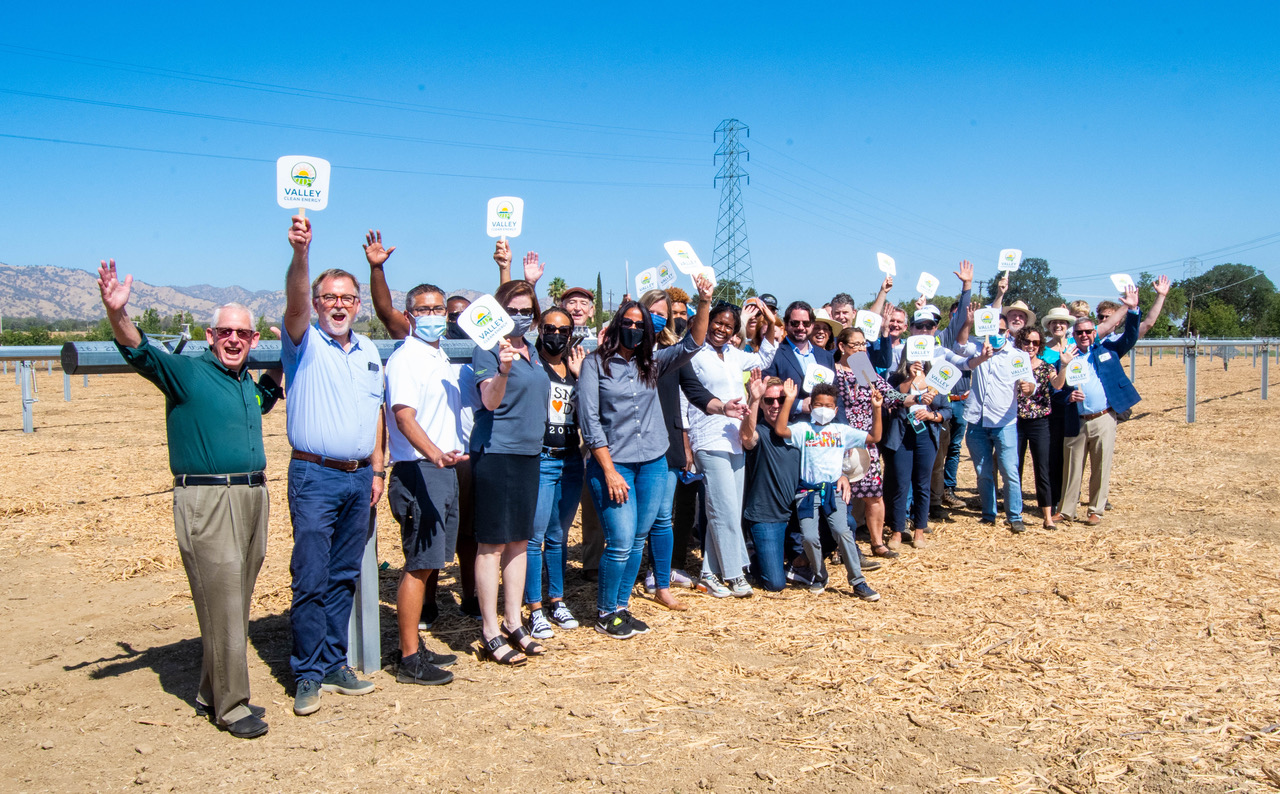

By Vanguard Staff
WINTERS, CA – With the public unveiling last week of a 3-megawatt solar-plus-storage farm west of Winters, Valley Clean Energy (VCE) took another step toward its goal of providing more local renewable power generation for its customers.
The 20-year agreement with Putah Creek Solar Farms, LLC, for 3 MW of solar energy and 3 MW of battery storage was approved by VCE’s board of directors last December. Valley Clean Energy is the local electricity provider for the cities of Winters, Woodland and Davis as well as the unincorporated portions of Yolo County.
At the public event Aug. 10, Assemblymember Cecilia Aguiar-Curry, a longtime Winters resident who was the city’s first female mayor, applauded Winters area farmer and project co-owner Dan Martinez as a “visionary,” while adding that California must triple its annual solar and wind installations to meet its goal of a carbon-neutral grid by 2045.
“Because of the threat of more frequent wildfires in California, we must do everything possible to increase local reliability in the electricity supply and systems,” Aguiar-Curry added, pointing to the Winters project as a key piece of the puzzle.
Winters City Councilmember Jesse Loren, vice- chair of the VCE board, reminded the gathering of local politicians, policymakers and industry professionals that VCE has set an ambitious goal of providing 80 percent renewable energy by 2030, with up to 25 percent of that coming from local sources.
“Winters is an agrarian community; it’s a farming community,” she said. “And do you know what we’re farming today? We’re farming energy, and I couldn’t be more proud of that.
“What we need are local jobs: that’s how we’ll reduce vehicle miles traveled, that’s how we will help with our own climate goals. And this is a beautiful match,” Loren said, pointing to the project site. “It’s local jobs, local energy, feeding our grid locally.”
Mitch Sears, interim general manager of VCE, told those present, “We’re here to mark an important milestone for energy production and planning at the local level.
“At about 3 megawatts, (the project) will serve close to 600 homes (about 8,000 to 9,000 megawatt hours) on an annual basis,” Sears said. “It’s small in comparison to what the need is, but it’s a step in the right direction.”
Sears said the project answers some of the objectives that the VCE board of directors has established: to diversify the local energy supply, to create local renewable energy jobs and to take action at the local level to address climate issues.
Co-benefits of the project, he added, include an opportunity to increase the efficiency and reliability of the local energy system and to promote better public understanding of how the electricity system works in Yolo County.
“So, practically speaking, being right next to the (PG&E) substation is as efficient as you can get,” Sears said.
Property owner Dan Martinez said the 8,262 photovoltaic panels and the battery storage system will occupy approximately 19 acres of a 31-acre property that once was a walnut orchard. Commercial operation of the project is expected by November.
The Putah Creek Land Co. also built a 15-acre solar array just south of this property in 2014; energy from that plant is sold to PG&E.
“Yolo County has a long history of protecting agricultural ground,” said Martinez, who is joined in this effort by his longtime business partner Santiago Moreno. “But they also understand the fact that there’s a balance. In this case, we’re removing trees that were one resource and now we’re producing a different resource.”
In addition to the Putah Creek Solar Farm, the VCE board also approved the Gibson Renewables project last December, which is expected to generate 20 MW of solar energy and provide 6.5 MW of battery energy storage. Commercial operation of that project, which will be built along Highway 16 between Madison and Esparto, is targeted for late 2022.
Together, the two projects are expected to satisfy nearly 10 percent of the energy needs of VCE’s entire service area.





I hate to see agriculture production land get covered over by solar panels. We should start with rooftops and parking lots. Then move on to land with lower quality soils. Replacing a walnut grove with solar? Does that mean class I soil? Its hard to derive from this article how much solar VCE needs in the long run but it looks like its going to add up to a few thousand acres. Maybe there could be a process to first determine a zoning process and eligible sites? Maybe VCE is doing this? An old walnut grove leaves me wondering.
A few thousand acres… even fewer sq. mi. (factor of 640)… have people ever flown over the valley?
I agree with Ron G… there is no reason why we should not follow his suggested priorities, to put last on the list prime AG, or sensitive habitats (like some desert areas). PVUSA was sited on the old sewage treatment plant… poor soils, a lot of ‘remediation would have been necessary to even bring it to ‘marginal’ AG productivity…
But I’m not concerned about ‘thousands of acres’, in any event.
Due to the new groundwater law, the Sustainable Groundwater Management Act, up to a million acres may have to be fallowed or retired over the next two decades because there isn’t sufficient water supply in the Valley. Solar panels are a viable, useful alternative.
I’m glad to see these projects combining solar with storage. This will displace more fossil methane from the grid.
A planning process for both groundwater retention and soil typing under solar arrays seems to be in order. By taking out lower grade soils and saving the water they would use to grow crops you would be reserving water for higher value crops that are grown on class I soils.
Appropriate implementation of the Sustainable Groundwater Management Act would entail farmers switching from woody crops to annual crops and fallowing the land when there is not sufficient rainfall. It would not entail taking a million acres out of food production.
It is very frustrating to me that productive agricultural land with adequate water supply is being taken out of production for solar panels. This is an accelerating trend and needs to be addressed.
At this point I don’t celebrate projects like this at all. It’s a terrible precedent.
Fully agree… do not celebrate it… but neither will I have nightmares about it.
I think you and Ron G are on the same page as I am (although we may word it differently)… soil class, water availability (not just 2021, but ‘potential’, historical and/or future), and I’d add ‘sensitive’ habitats… deserts have poor soil classes, little water, but many are precious to protect ecosystems.
Solar, good… ag (particularly prime ag), good… environmental/species survival, good…
All should be seen in a ‘(w)holistic’ way… IMNSHO
And Don, since it is only a groundbreaking, why not mount an effort to get a TRO issued to stop this ‘travesty’, as you appear to support the proposed TRO @ Sutter? That would be ‘consistent’…